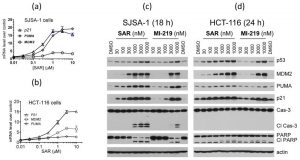| CAS NO: | 1303607-60-4 |
| 规格: | ≥98% |
| 包装 | 价格(元) |
| 2mg | 电议 |
| 5mg | 电议 |
| 10mg | 电议 |
| 25mg | 电议 |
| 50mg | 电议 |
| 100mg | 电议 |
| 250mg | 电议 |
| Molecular Weight (MW) | 562.50 |
|---|---|
| Formula | C29H34Cl2FN3O3 |
| CAS No. | 1303607-60-4 |
| Storage | -20℃ for 3 years in powder form |
| -80℃ for 2 years in solvent | |
| Solubility (In vitro) | DMSO: 100 mg/mL (177.77 mM) |
| Water:<1 mg/mL (slightly soluble or insoluble) | |
| Ethanol: 31 mg/mL warming (55.11 mM) | |
| Other info | InChi Key: IDKAKZRYYDCJDU-HBMMIIHUSA-N InChi Code: InChI=1S/C29H34Cl2FN3O3/c1-28(2,3)14-22-29(19-12-7-15(30)13-21(19)34-27(29)38)23(18-5-4-6-20(31)24(18)32)25(35-22)26(37)33-16-8-10-17(36)11-9-16/h4-7,12-13,16-17,22-23,25,35-36H,8-11,14H2,1-3H3,(H,33,37)(H,34,38)/t16-,17-,22-,23-,25+,29+/m0/s1 SMILES Code: O=C([C@H](N[C@H]1CC(C)(C)C)[C@H](C2=CC=CC(Cl)=C2F)[C@@]31C(NC4=C3C=CC(Cl)=C4)=O)N[C@H]5CC[C@H](O)CC5 |
| Chemical Name/Synonyms | (2'S,3R,4'S,5'R)-6-chloro-4'-(3-chloro-2-fluorophenyl)-N-((1r,4R)-4-hydroxycyclohexyl)-2'-neopentyl-2-oxospiro[indoline-3,3'-pyrrolidine]-5'-carboxamide; SAR-405838; SAR 405838; SAR405838; MI-773; MI773; MI 773 |
| In Vitro | MI-773 potently inhibits cell growth in cancer cell lines, including SJSA-1 (IC50, 0.092 μM), RS4;11 (IC50, 0.089 μM), LNCaP (IC50, 0.27 μM), and HCT-116 (IC50, 0.20 μM) cells, and displays high selectivity over cancer cell lines with mutated or deleted p53, including SAOS-2 (IC50,>10 μM), PC-3 (IC50,>10 μM), SW620 (IC50,>10 μM), and HCT-116 (p53-/-) (IC50,>20 μM) cells |
|---|---|
| In Vivo | In the SJSA-1 osteosarcoma, acute lymphoblastic leukemia RS4;11, LNCaP prostate cancer, and HCT-116 colon cancer xenograft model, MI-773 (p.o.) effectively inhibits tumor growth in a dose-dependent manner (10 mg/kg, 30 mg/kg, 50 mg/kg, 100 mg/kg, and 200 mg/kg). |
| Animal model | SCID mice with SJSA-1 osteosarcoma (females), acute lymphoblastic leukemia RS4;11 (females), LNCaP prostate cancer (males), or HCT-116 colon cancer (females) xenograft model |
| Formulation & Dosages | 10% PEG400: 3% Cremophor: 87% PBS, or 2% TPGS: 98% PEG200; 200 mg/kg; Oral |
| References | [1] Wang S, et al. Cancer Res. 2014, 74(20), 5855-5865. |
|
|  Microsoft Word - NIHMS621402-manuscript-1SAR405838 potently activates p53 in the SJSA-1 and HCT-116 cancer cell lines and strongly induces PUMA up-regulation and cleavage of caspase-3 and PARP in the SJSA-1 cell line but not in the HCT-116 cell line. Wang S, et al. Cancer Res. 2014, 74(20), 5855-5865. |
